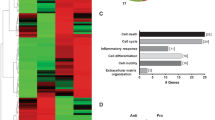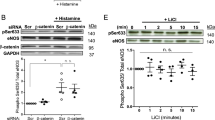Abstract
Weibel–Palade bodies are uniquely present in endothelial cells and harbor a range of bioactive substances that participate in hemostasis, vasomotion, inflammation and fibrinolysis, in addition to modulating vascular permeability, angiogenic sprouting, and stem cell mobilization. This Perspectives article examines the latest insights into the biogenesis of these organelles and the cellular and molecular mechanisms of their exocytosis. In addition, we advance two hypotheses on the pathogenic role of these organelles: first, in the development of endothelial dysfunction associated with the reduction of nitric oxide bioavailability and accumulation of peroxynitrite and second, as a first-line response to acute stress that determines the balance between regenerative and proinflammatory signals.
This is a preview of subscription content, access via your institution
Access options
Subscribe to this journal
Receive 12 print issues and online access
$209.00 per year
only $17.42 per issue
Buy this article
- Purchase on Springer Link
- Instant access to full article PDF
Prices may be subject to local taxes which are calculated during checkout



Similar content being viewed by others
References
Weibel, E. R. & Palade, G. E. New cytoplasmic components in arterial endothelia. J. Cell Biol. 23, 101–112 (1964).
Metcalf, D. J., Nightingale, T. D., Zenner, H. L., Lui-Roberts, W. W. & Cutler, D. F. Formation and function of Weibel–Palade bodies. J. Cell Sci. 121, 19–27 (2008).
Lowenstein, C. J., Morrell, C. N. & Yamakuchi, M. Regulation of Weibel–Palade body exocytosis. Trends Cardiovasc. Med. 15, 302–308 (2005).
Valentijn, K. M., Valentijn, J. A., Jansen, K. A. & Koster, A. J. A new look at Weibel–Palade body structure in endothelial cells using electron tomography. J. Struct. Biol. 161, 447–458 (2008).
Rondaij, M. G., Bierings, R., Kragt, A., van Mourik, J. A. & Voorberg, J. Dynamics and plasticity of Weibel–Palade bodies in endothelial cells. Arterioscler. Thromb. Vasc. Biol. 26, 1002–1007 (2006).
Wolff, B., Burns, A. R., Middleton, J. & Rot, A. Endothelial cell 'memory' of inflammatory stimulation: human venular endothelial cells store interleukin 8 in Weibel–Palade bodies. J. Exp. Med. 188, 1757–1762 (1998).
Øynebråten, I., Bakke, O., Brandtzaeg, P., Johansen, F. E. & Haraldsen, G. Rapid chemokine secretion from endothelial cells originates from 2 distinct compartments. Blood 104, 314–320 (2004).
Fiedler, U. et al. The Tie-2 ligand angiopoietin 2 is stored in and rapidly released upon stimulation from endothelial cell Weibel–Palade bodies. Blood 103, 4150–4156 (2004).
Kobayashi, T. et al. The tetraspanin CD63/lamp3 cycles between endocytic and secretory compartments in human endothelial cells. Mol. Biol. Cell. 11, 1829–1843 (2000).
Matsushita, K. et al. Nitric oxide regulates exocytosis by S-nitrosylation of N-ethylmaleimide-sensitive factor. Cell 115, 139–150 (2003).
Morange, P. E. et al. Endothelial cell markers and the risk of coronary heart disease: the Prospective Epidemiological Study of Myocardial Infarction (PRIME) study. Circulation 109, 1343–1348 (2004).
Nybo, M. & Rasmussen, L. M. The capability of plasma osteoprotegerin as a predictor of cardiovascular disease: a systematic literature review. Eur. J. Endocrinol. 159, 603–608 (2008).
Förstermann, U. & Münzel, T. Endothelial nitric oxide synthase in vascular disease: from marvel to menace. Circulation 113, 1708–1714 (2006).
Simmons, E. M. et al. Plasma cytokine levels predict mortality in patients with acute renal failure. Kidney Int. 65, 1357–1365 (2004).
Araki, M. et al. Expression of IL-8 during reperfusion of renal allografts is dependent on ischemic time. Transplantation 81, 783–788 (2006).
Pinsky, D. J. et al. Hypoxia-induced exocytosis of endothelial cell Weibel–Palade bodies. A mechanism for rapid neutrophil recruitment after cardiac preservation. J. Clin. Invest. 97, 493–500 (1996).
Kuo, M. C. et al. Ischemia-induced exocytosis of Weibel–Palade bodies mobilizes stem cells. J. Am. Soc. Nephrol. 19, 2321–2330 (2008).
Patschan, D., Patschan, S., Gobe, G. G., Chintala, S. & Goligorsky, M. S. Uric acid heralds ischemic tissue injury to mobilize endothelial progenitor cells. J. Am. Soc. Nephrol. 18, 1516–1524 (2007).
Leemans, J. C. et al. Renal-associated TLR2 mediates ischemia/reperfusion injury in the kidney. J. Clin. Invest. 115, 2894–2903 (2005).
Favre, J. et al. Toll-like receptors 2-deficient mice are protected against postischemic coronary endothelial dysfunction. Arterioscler. Thromb. Vasc. Biol. 27, 1064–1071 (2007).
Wu, H. et al. TLR4 activation mediates kidney ischemia/reperfusion injury. J. Clin. Invest. 117, 2847–2859 (2007).
Chun, J. & Prince, A. Activation of Ca2+-dependent signaling by TLR2. J. Immunol. 177, 1330–1337 (2006).
Schömig, K. et al. Interleukin-8 is associated with circulating CD133+ progenitor cells in acute myocardial infarction. Eur. Heart J. 27, 1032–1037 (2006).
He, T., Peterson, T. E. & Katusic, Z. S. Paracrine mitogenic effect of human endothelial progenitor cells: role of interleukin-8. Am. J. Physiol. Heart Circ. Physiol. 289, H968–H972 (2005).
Kocher, A. A. et al. Myocardial homing and neovascularization by human bone marrow angioblasts is regulated by IL-8/Gro CXC chemokines. J. Mol. Cell. Cardiol. 40, 455–464 (2006).
Udani, V. et al. Differential expression of angiopoietin 1 and angiopoietin 2 may enhance recruitment of bone marrow-derived endothelial precursor cells into brain tumors. Neurol. Res. 27, 801–806 (2005).
Daly, C. et al. Angiopoietin 2 functions as an autocrine protective factor in stressed endothelial cells. Proc. Natl Acad. Sci. USA 103, 15491–15496 (2006).
Asahara, T. et al. VEGF contributes to postnatal neovascularization by mobilizing bone marrow-derived endothelial progenitor cells. EMBO J. 18, 3964–3972 (1999).
Matsushita, K. et al. Vascular endothelial growth factor regulation of Weibel–Palade-body exocytosis. Blood 105, 207–214 (2005).
Chavakis, E. et al. High-mobility group box 1 activates integrin-dependent homing of endothelial progenitor cells. Circ. Res. 100, 204–212 (2007).
Bertuglia, S. et al. ITF1697, a stable Lys–Pro-containing peptide, inhibits Weibel–Palade body exocytosis induced by ischemia/reperfusion and pressure elevation. Mol. Med. 13, 615–624 (2007).
Yamakuchi, M. et al. HMG-CoA reductase inhibitors inhibit endothelial exocytosis and decrease myocardial infarct size. Circ. Res. 96, 1185–1192 (2005).
Acknowledgements
Studies in the authors' laboratory were supported in part by NIH grants DK54602, DK052783 and DK45462 and by Westchester Artificial Kidney Foundation (M. S. Goligorsky) and a Fellowship grant from the Deutsche Forschungsgemeinschaft (PA 1530/3-1; D. Patschan).
Author information
Authors and Affiliations
Corresponding author
Ethics declarations
Competing interests
The authors declare no competing financial interests.
Rights and permissions
About this article
Cite this article
Goligorsky, M., Patschan, D. & Kuo, MC. Weibel–Palade bodies—sentinels of acute stress. Nat Rev Nephrol 5, 423–426 (2009). https://doi.org/10.1038/nrneph.2009.87
Issue Date:
DOI: https://doi.org/10.1038/nrneph.2009.87
This article is cited by
-
Association of circulating angiogenesis inhibitors and asymmetric dimethyl arginine with coronary plaque burden
Fibrogenesis & Tissue Repair (2015)
-
Acute kidney injury: a conspiracy of toll-like receptor 4 on endothelia, leukocytes, and tubules
Pediatric Nephrology (2012)
-
Toll-like receptor 4 regulates early endothelial activation during ischemic acute kidney injury
Kidney International (2011)
-
Sphingolipids and the Orchestration of Endothelium-Derived Vasoactive Factors: When Endothelial Function Demands Greasing
Molecules and Cells (2010)



